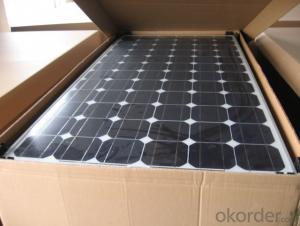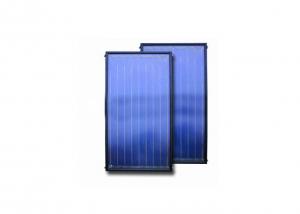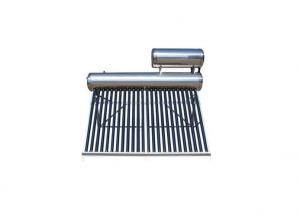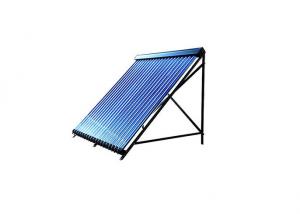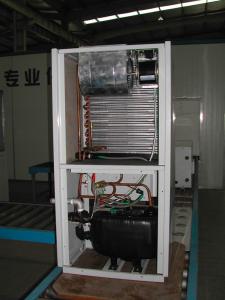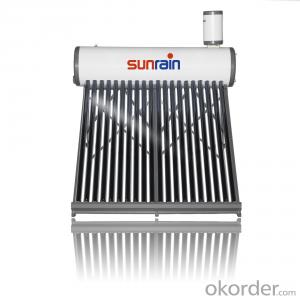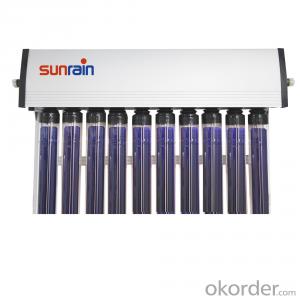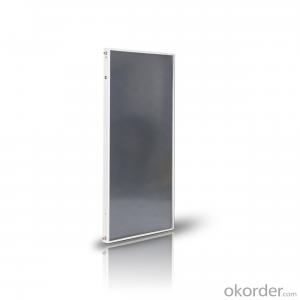CNBM Solar Monocrystalline Series Panels
- Loading Port:
- Tianjin
- Payment Terms:
- TT OR LC
- Min Order Qty:
- 1 pallet
- Supply Capability:
- 100000000 pallet/month
OKorder Service Pledge
OKorder Financial Service
You Might Also Like
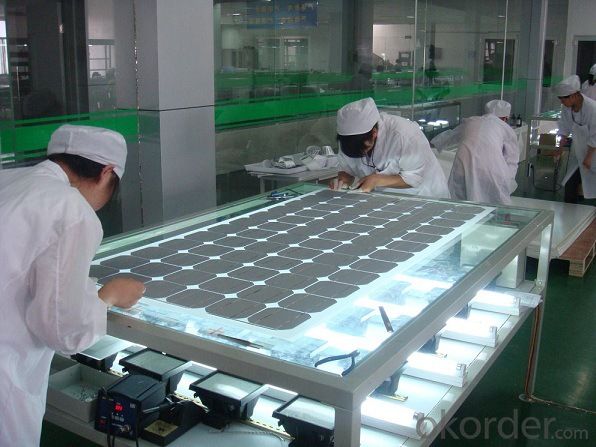
Product Description:
Solar Monocrystalline Series Panels
Introduction of Solar Monocrystalline Series Panels
CNBM Solar photovoltaic (PV) Panel is designed for large electrical power requirements. It is the optimal choice for both on-grid and off-grid power systems. CNBM Solar panel offers high performance of power per square foot of solar array. Monocrystalline silicon(c-Si): often made using the Czochralski process. Single-crystal wafer cells tend to be expensive, and because they are cut from cylindrical ingots, do not completely cover a square solar cell module without a substantial waste of refined silicon. Hence most c-Si panels have uncovered gaps at the four corners of the cells.
Characteristics of Solar Monocrystalline Series Panels
I Solar Cell : High efficiency crystalline solar cell. Even if under the weak light, the solar module can produce maximum power output.
II Tempered glass (toughened glass): Anti-reflecting coating and high transmission rate glass increase the power output and mechanical strength of solar module.
III EVA and TPT: Using high quality EVA and TPT to prevent destroying and water.
IV AI frame: Without screw, corner connection. 6 holes on the frame can be installed easily.
V Junction box: Multi function junction box with water proof.
VI Long lifetime: ≥25 years; Less power decrease
VII Good performance of preventing from atrocious weather such as wind and hails.
VIII Resisting moisture and etching effectively, not effected by geology.
Standard Test Conditions of Solar Monocrystalline Series Panels
The opto-electrical specifications shown below are stabilized values being measured at Standard Test Conditions, Irradiance: 1000W/m2, Spectrum: AM1.5 at 25°C, The info below is subject to manufacturing tolerances. Where appropriate minutes of measurement are available and are used for the dimensioning of the installation.
Advantages of Solar Monocrystalline Series Panels
• CNBM Solar performance guarantees for 25 years
• 12 years guarantee for workmanship
• Timeliness of delivery
CNBM International Corporation's products including Monocrystalline Solar Panel, Polycrystalline Solar Panel have received and enjoyed famous reputation in many countries and regions in the world .As a solar panel supplier in China, we strive to provide our customers with excellent service, superior products and unmatched value.
Characteristics of Solar Monocrystalline Series Panels
Max Power Voltage Vmp (V) | 18.4V | 17.6V |
Max Power Current Imp (A) | 6.52A | 7.39A |
Open Circuit Voltage Voc (V) | 23.0V | 22.2V |
Short Circuit Current Isc (A) | 6.97A | 7.90A |
Max Power Pm (W) | 120W | 130W |
Temperature Coefficient of Cells
NOCT | 47℃±2℃ |
Temperature Coefficients of Isc (%/℃) | 0.064 |
Temperature Coefficients of Voc (%/℃) | -0.33 |
Temperature Coefficients of Pmp (%/℃) | -0.45 |
Mechanical Data Solar Monocrystalline Series
Power | 120W/130W |
Dimension | 1190/1470×670×30mm |
Weight | 9.5kg/11.7kg |
Tolerance | ±3% |
The dimension of the modules can be changed according to the demand of clients
Limits
Operating Temperature | –40 °C to +85°C |
Storage Temperature | –40 °C to +85°C |
Max System Voltage | 700V |
Guarantee Solar Monocrystalline Series Panels
Products Guarantee | 10 yrs free from defects in materials and workmanship |
Performance Guarantee | No less than 90% within 10yrs and no less than 80% within 25yrs |
Certificates | IEC, ISO, TUV, CE |
FAQ
We have organized several common questions for our clients,may help you sincerely:
1. What’s price per watt?
A: It’s depends on the quantity, delivery date and payment terms of the order. We can talk further about the detail price issue. Our products is high quality with lower price level.
2. Can you tell me the parameter of your solar panels?
We have different series of cells with different power output, both from c-si to a-si. Please take our specification sheet for your reference.
3. How do you pack your products?
We have rich experience on how to pack the panels to make sure the safety on shipment when it arrives at the destination.
4. Can you do OEM for us?
Yes, we can.
5. How long can we receive the product after purchase?
In the purchase of product within three working days, We will arrange the factory delivery as soon as possible. The perfect time of receiving is related to the state and position of customers. Commonly 7 to 10 working days can be served.
- Q:Can a solar water heater be used in areas with high levels of airborne particles?
- Yes, a solar water heater can generally be used in areas with high levels of airborne particles. However, it is important to regularly clean and maintain the system, especially the solar collectors, to ensure optimal performance and prevent the build-up of particles that may hinder the absorption of sunlight.
- Q:Can a solar water heater be integrated with an existing plumbing system?
- Certainly, it is entirely possible to incorporate a solar water heater into an already established plumbing system. In actuality, it is quite customary to retrofit solar water heaters into existing plumbing systems. The process of integration typically entails joining the solar water heater to the preexisting hot water line. This can be accomplished by incorporating a heat exchanger or a pre-heat tank that facilitates the flow of solar-heated water, allowing it to combine with the existing hot water supply. Furthermore, it is possible to install a backup heating system, such as a gas or electric water heater, in order to ensure a supply of hot water during periods of limited availability of solar energy. All in all, integrating a solar water heater with an existing plumbing system is a practical and efficient means of harnessing the sun's energy and reducing dependence on traditional water heating methods.
- Q:Can a solar water heater be used for heating swimming pools or hot tubs?
- Yes, a solar water heater can be used for heating swimming pools or hot tubs. Solar water heating systems are designed to capture and utilize solar energy to heat water, making them an efficient and environmentally friendly option for heating large bodies of water. By utilizing solar collectors and a circulation system, the heat generated can be transferred to the pool or hot tub, providing comfortable water temperatures for swimming or relaxation.
- Q:Does a solar water heater require batteries?
- Batteries are not necessary for a solar water heater. Unlike solar panels that convert sunlight into electricity and store it in batteries, solar water heaters utilize the sun's energy directly to heat water. Generally, they are composed of a solar collector that absorbs sunlight and transfers heat to either a water storage tank or pipes. Consequently, the water is heated and stored for later use. Thus, solar water heaters operate without the need for batteries, making them a cost-effective and energy-efficient solution for water heating.
- Q:How does the size of a solar collector affect the performance of a solar water heater?
- The size of a solar collector greatly affects the performance of a solar water heater. A larger collector size allows for a greater surface area to absorb solar radiation, resulting in more heat being transferred to the water. This means that a larger collector can heat a larger volume of water more efficiently, providing a higher hot water output. Additionally, a larger collector size increases the overall efficiency of the solar water heater. With a larger surface area, the collector can capture more sunlight and convert it into heat energy. This means that a larger collector can generate higher temperatures, even in colder weather conditions, and can operate more effectively in areas with less intense solar radiation. Furthermore, the size of the solar collector also affects the duration of heat retention. A larger collector can store more heat energy, allowing for a longer period of hot water availability, especially during times when there is limited solar radiation, such as cloudy days or at night. However, it is important to note that the size of the solar collector should be balanced with the hot water demand. If the collector is too large for the water heating requirements, it may result in excessive heat production, leading to wasted energy. On the other hand, if the collector is too small, it may not be able to meet the hot water demand efficiently. In conclusion, the size of a solar collector is a crucial factor in determining the performance of a solar water heater. A larger collector size offers benefits such as increased heat absorption, higher temperatures, and longer heat retention, resulting in improved efficiency and hot water output. However, it is essential to find the right balance between collector size and hot water demand to ensure optimal performance and energy utilization.
- Q:How does a solar water heater affect water heater heat loss?
- A solar water heater can significantly reduce water heater heat loss compared to traditional water heaters. The main reason for heat loss in water heaters is the transfer of heat through the walls of the tank and the pipes. In a solar water heater, the water is heated directly by the sun's energy using solar collectors, which are typically placed on the roof or in an open area with maximum exposure to sunlight. This direct heating process eliminates the need for a conventional heating element or burner, which reduces heat loss caused by conduction and radiation. Moreover, solar water heaters are typically equipped with well-insulated storage tanks to minimize heat loss through the tank walls. The tanks are often insulated with materials like foam or fiberglass, which have high thermal resistance and prevent heat from escaping. This insulation significantly reduces heat loss compared to non-insulated tanks commonly found in conventional water heaters. Additionally, solar water heaters often use circulation pumps or natural thermosiphon systems to transfer heated water from the collectors to the storage tank. These systems are designed to minimize heat loss during the transportation of hot water by using well-insulated pipes and ensuring efficient flow rates. Overall, a solar water heater can greatly reduce heat loss by utilizing direct solar energy for heating and incorporating efficient insulation and circulation systems. This leads to lower energy consumption and cost savings, making solar water heaters an environmentally friendly and economically viable option.
- Q:Are solar water heaters safe?
- Yes, solar water heaters are generally considered safe. They do not pose any significant safety risks as long as they are properly installed, maintained, and operated according to manufacturer's guidelines.
- Q:Can a solar water heater be used in areas with strict water temperature regulations?
- Yes, a solar water heater can be used in areas with strict water temperature regulations. Solar water heaters typically have temperature control mechanisms such as thermostats and mixing valves that allow users to set and regulate the desired water temperature. These mechanisms ensure that the water temperature complies with the regulations while still utilizing solar energy for heating.
- Q:The solar water heater without water becomes bad
- If you do not use it for a while, it is recommended that you use a blanket, carpet or quilt to cover the vacuum tube to avoid sun exposure.Other parts of the air drying will not cause problems.
- Q:Can a solar water heater be used in conjunction with a swimming pool?
- Yes, a solar water heater can be used in conjunction with a swimming pool. Solar water heaters use energy from the sun to heat water, and this heated water can be pumped into a swimming pool to increase its temperature. It is an eco-friendly and cost-effective way to heat pool water, reducing the reliance on traditional heating methods.
1. Manufacturer Overview |
|
|---|---|
| Location | |
| Year Established | |
| Annual Output Value | |
| Main Markets | |
| Company Certifications | |
2. Manufacturer Certificates |
|
|---|---|
| a) Certification Name | |
| Range | |
| Reference | |
| Validity Period | |
3. Manufacturer Capability |
|
|---|---|
| a)Trade Capacity | |
| Nearest Port | |
| Export Percentage | |
| No.of Employees in Trade Department | |
| Language Spoken: | |
| b)Factory Information | |
| Factory Size: | |
| No. of Production Lines | |
| Contract Manufacturing | |
| Product Price Range | |
Send your message to us
CNBM Solar Monocrystalline Series Panels
- Loading Port:
- Tianjin
- Payment Terms:
- TT OR LC
- Min Order Qty:
- 1 pallet
- Supply Capability:
- 100000000 pallet/month
OKorder Service Pledge
OKorder Financial Service
Similar products
New products
Hot products
Related keywords
